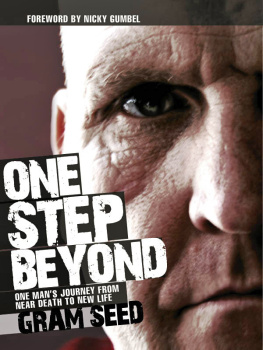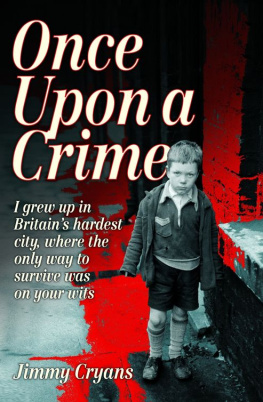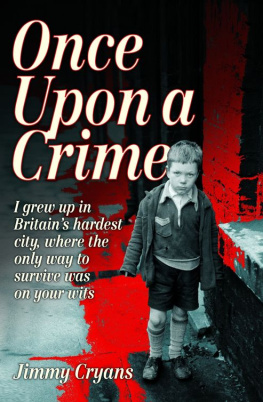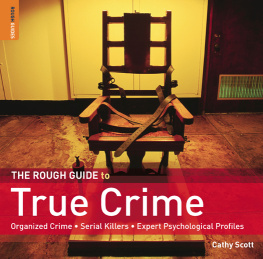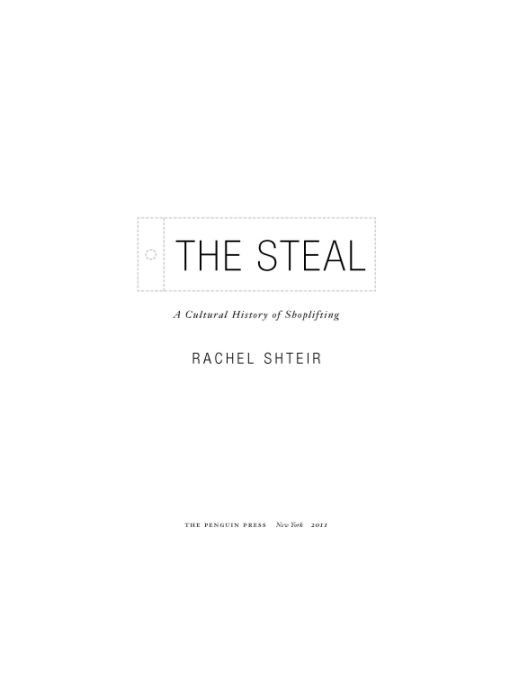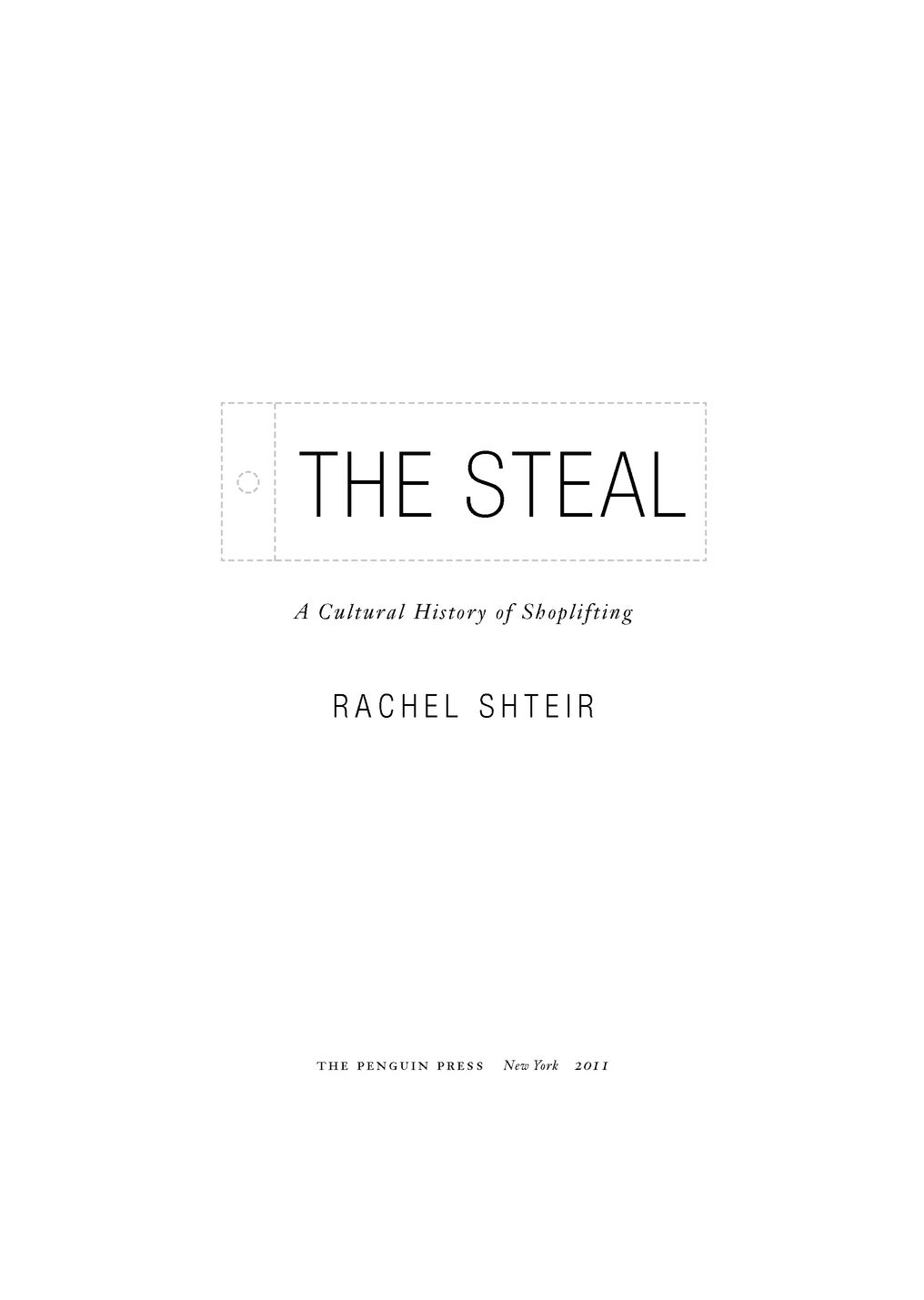Table of Contents
ALSO BY RACHEL SHTEIR
Gypsy: The Art of the Tease
Striptease: The Untold History of the Girlie Show
For MK, and for RR
They were not thieves by heredity; they were made. And the manufacture goes on every day. The street and the jail are the factories.
Jacob Riis, The Making of an American
In fiction the recourse of the powerless is murder. In real life it is petty theft.
Earl Shorris
Deres little stealin like you does, and deres big stea- lin like I does. For de little stealin, dey gits you in jail soon or late. For de big stealin dey makes you Emperor and puts you in de Hall o Fame when you croaks.
Eugene ONeill, The Emperor Jones
INTRODUCTION
It is 4:19 p.m. on December 12, 2001. In the socks and hose area on the first floor of this posh department store, a slight, dark-haired woman wearing a beige three-quarter coat with a tab collar, a black skirt, and boots is struggling under the weight of her shopping bags. Her hair is swept back in a loose ponytail. She has sharp features, and in the creases of her deep-set eyes, you can make out shadows that look like her eyelashes. She is carrying many bags. There is a bulky, dark garment bag, either navy blue or black, which looks like it is stuffed with clothing, and a red, rectangular shopping bag. The woman is also carrying a tote bag and two purses, a white one and a turquoise one. Her thin face might register troublefear or guilt or sadnessit is difficult to tell because the surveillance video does not have good resolution.
The backdrop is more clearly visible: She is walking among mirrored pillars and display cases, crystal chandeliers, and caramel-colored wood paneling. All around are socks and stockings made of silk, cashmere, and fine wool. This is not the kind of store that caters to basic needs.
Indeed, in 1938, the architect designed this store to resemble a movie stars home. The first black-and-white photos show sinuously curved walls, elegant Regency furniture, and subdued lighting. There is a sense of spaciousness in these photos. This store was also one of the first ones in the United States to be divided into individual boutiques so that customers would feel as though they had just stumbled out of bed, surrounded by even more fabulous clothes than the ones hanging in their closets. Each boutique conjured a specific destination: Swimwear looked like a tropical resort.
Perhaps it is the harsh color or the low-quality image of the surveillance video, or the metal fixtures or the number of products piled on the shelves, but the store today is cold and uninviting, crowded, devoid of its original elegance. Three handbags the size of small dogs crouch on a wooden end table. The woman is between the hat boutique and the hose boutique of the accessories department when the amount of stuff she is carrying overpowers her. She drops something and squats on the floor to pick it up. She begins messing about in the garment bag and the shopping bag. After a few minutes of shuffling (there is a digital clock in the upper-right-hand corner of the screen and you can see time passing), she crams one or two pairs of socks and some hair bands into the crown of a hat, which she plops on top of the clothing and bags. She hoists herself off the floor and wanders back to the hat section. From a wooden shelf, she takes a floppy black hat and sets it on her head. The tag hangs in front of her ear. She takes off that hat and tries one whose brim hides more of her face.
The woman moves past the cosmetics counters to the up escalator. On the second floor, the hat, the socks, and the headbands are no longer visible. A little while later, a camera picks her up again on the third floor at the Gucci boutique. She is still wearing the second hat, but you cannot see its price tag. She peels a white, strappy dress and some other items from their hangers and piles them on top of her bags. She visits Marc Jacobs, Yves Saint Laurent, Jil Sander, and Chanel and chooses clothing from these boutiques. It is 5:19. She brushes up against a rack of Chanel coats. A camera lingers on her back as she sets foot on the down escalator. Two naked alabaster mannequins recede behind her as she adjusts the garment bag over her shoulder.
The woman is now heading toward the exit. A camera zooms in. She cuts through the shoe department. She glides to the plate-glass doors. Another camera zooms in, this time on her back. Another picks her up from the front and another from her side. She passes a cash register. Her reflection looms in the glass doors as she walks toward them, and just before she pushes past the shoes, she tosses the garment bag once more over her shoulder. She is outside.
Like windup toys set in motion by the department-store Oz, two security guardsa stocky man and a woman in a long, dark skirtwalk stiffly after the woman into the parking lot. You can just make out a confrontation in the shadows. A third guard joins the group. The woman tilts her head, listening. She doesnt resist. It is not as if anyone is a criminal here. When she comes back inside the store, she is flanked by two of the guards. The trio walks back down the marble aisle. The guards have divvied up her bags. There is no tension among them. They appear to be exchanging pleasantries as they stroll to the down escalator. They vanish, their destination the holding room in the basement, where the woman will be interviewed, and where she will be turned over to the police. The screen goes fuzzy. Its 5:37 p.m. in Saks Fifth Avenue, Beverly Hills. Winona Ryder is about to join that notorious categorythe celebrity shoplifter.
I watched the videos tracking Ryder in a conference room behind the Beverly Hills courthouse in the summer of 2007. But I first became fascinated by the movie star four years earlier, after I read excerpts from the Court TV transcripts of her trial and studied the few clips of surveillance camera footage posted on the Internet. Along with millions of Americans, I wondered why a Hollywood star would shoplift.
At first I resisted writing about the subject but soon came to realize that there was more to my fascination than prurience or schadenfreude. I am inveterately curious about the boundaries cultures establish: the lines we draw between civilization and barbarism, madness and sanity, the appropriate and the inappropriate. We live by these boundaries. And yet the line we draw for shoplifting is murky: Is it a serious crime worthy of criminal prosecution, or what Andr Gide would call an acte gratuitan impulsive, unpredictable act, childish, but deserving of forgiveness? Is it a disease or a symbol of greed? How has our response to shoplifting changed over time? Who are the outliers and who are the scapegoats? What does it mean that more and more white-collar shoplifters are caught committing the crime? How is shoplifting connected to the economy and to consumption? Do shoplifters grow up to rob banks and embezzle multinationals?
I wrote this book because, unlike gambling, which has a history, a medicine, and a literature, shoplifting remains unwritten. I met shoplifters by placing ads on Craigslist and by joining listservs for those suffering from obsessive-compulsive disorder. Some shoplifters I literally met at dinner parties or while interviewing people at Starbucks. Psychiatrists and mental health counselors asked their patients if they would talk to me. A handful of probation and police officers, security personnel, and not-for-profit groups serving shoplifters helped, as did a few scholars.



